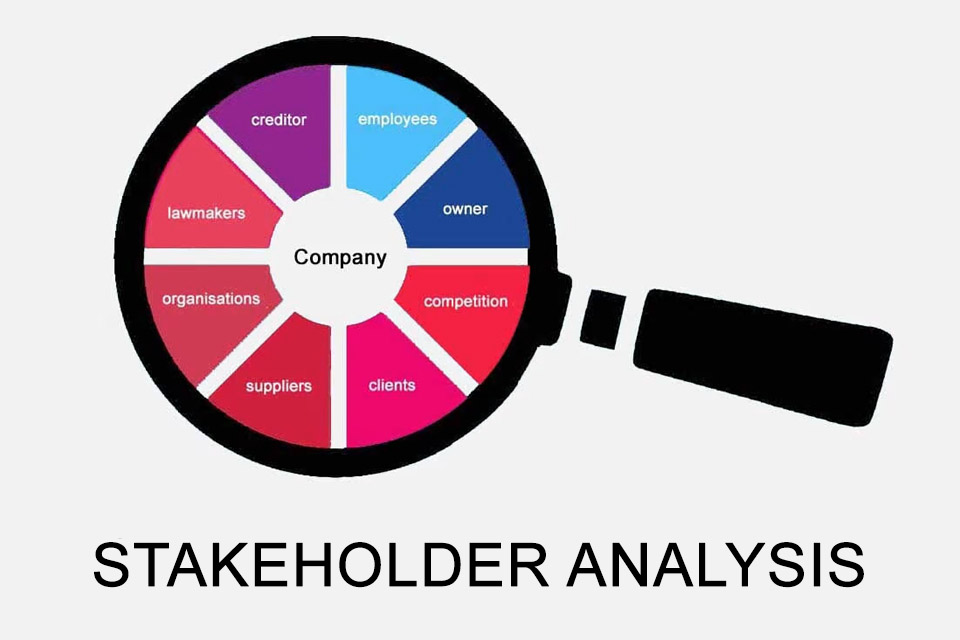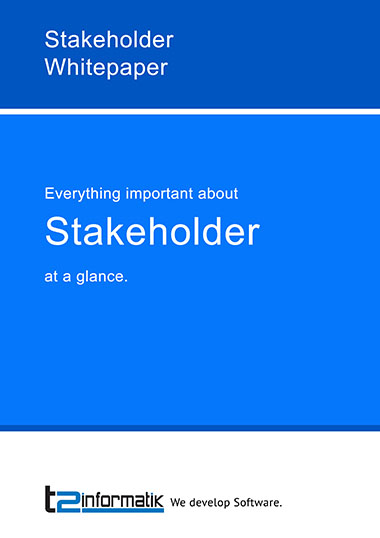What is a Stakeholder Analysis?
Table of Contents: Definition – Techniques – Procedure – Evaluation – Tips – Questions – Download – Notes
Smartpedia: Stakeholder analysis identifies the goals, motives and attitudes of individuals and organisations that are directly or indirectly affected by or have an interest in the activities of a company.
Stakeholder analysis definition
Employees and customers, suppliers and partners, trade unions, associations and consumer organisations, capital providers such as owners, silent partners, shareholders or banks, competitors, institutions, authorities or legislators are considered “typical” stakeholders. The stakeholder analysis identifies the most important stakeholders for a project, undertaking or development, their goals, motives and attitudes.
In the course of stakeholder management, the stakeholder analysis follows stakeholder identification. With its help
- supporters and promoters who want to advance a project, can be found,
- opponents, obstacles and resistance that may emanate from certain persons or institutions can be recognised,
- objectives from both supporters and opponents can be identified, and
- relationships and conflicts between stakeholders can be highlighted.
And that is how you lay the foundation for stakeholder communication.
Stakeholder analysis techniques
How do you find out what a stakeholder wants? The choice of the best technique depends on the project conditions, the skills of the investigating team and the type of knowledge to be sought:
- Survey techniques help to identify explicit knowledge. Examples of survey techniques are questionnaires and interviews.
- Creativity techniques are used to identify visions of products. Examples of creativity techniques are brainstorming, brainwriting and braindumping. These techniques are often used in the course of workshops.
- Observation techniques are useful in situations that are difficult to describe. Examples of observation techniques are field observation and apprenticing.
- Document centred techniques are used in combination with other techniques. They try to use known solutions in the context of analysis. Examples of document-centered techniques are perspective-based reading and systems archaeology.
Procedure for stakeholder analysis
The following procedure is recommended in the course of stakeholder analysis:
- List all persons and organisations by name. In addition to the contact data, record the appropriate communication options and times. Also document the locations.
- Record the influence, attitude and motivation of each stakeholder on the project and its goals. The possibilities of influencing (how easily he can be influenced, how he influences others) should also be described.
- Document the areas of knowledge and contextual experiences. Existing methodological knowledge and expertise should also be written down.
- Evaluate and prioritise each stakeholder.
- Version your findings, because this will allow you to trace changes in projects back to changes in stakeholders at a later stage.
Evaluation of stakeholders
An important result of stakeholder analysis is the distinction between important and less important stakeholders. You can assess your stakeholders in different categories:
- What influence does the stakeholder have on your project?
- How great is the interest? In order to answer the question, it is a good idea to shed light on the change for the stakeholder: What changes are there in the way he works? What influence will the change have on his future position in the company? What opportunities and risks arise for him?
- What will be the reactions of individuals or organisations? Do you have to reckon with hidden or open resistance due to your project and the changes that accompany it? Or are the consequences for the stakeholder so positive that it promotes and promotes your project?
- How powerful is the stakeholder? When assessing power, it is irrelevant whether he has direct influence like a superior or indirect influence as an external organisation. It is important to recognise that negative effects often lead to demonstrations of power and are difficult to combat.
In most cases, it is sufficient to work with simple gradations such as “low, medium, high”, since these are subjective assessments, so that more detailed gradations would provide little additional insight.
Tips for stakeholder analysis
There are a number of tips to help with stakeholder analysis:
- The result of the analysis is a snapshot. Attitudes, opinions and also influences often change in the course of a project. It is therefore worth questioning the results from time to time and adjusting them if necessary.
- The results of an analysis should not be transferred to other similar projects without verification. Lack of time is no justification for “shortcuts”. There may be a risk of a serious, incorrect classification of stakeholders.
- People tend to have prejudices. Although this is difficult to prevent, a “neutral” stakeholder analysis should be sought.
- Corporate hierarchies are not necessarily an indicator of the influence of people. Particularly in times when leadership is increasingly moving away from roles and positions, it is important to avoid false, hasty judgements.
- Personal relationships may lead to consumption or incorrect judgements. It is therefore advisable to have a “critical” dialogue with colleagues who are also involved in the analysis.
- It is often recommended that stakeholders be grouped together, as this makes it easier, for example, to define joint measures. But: people are individuals. Therefore, grouping or allocation to groups should also be scrutinised from time to time, or even questioned in principle.
- And last but not least: the results of the stakeholder analysis are confidential and not public. There must be clarity about this among those involved.
Questions from the field
Here you will find some questions and answers from the field:
What is stakeholder management?
Stakeholder management addresses the targeted, continuous dialogue between a company and its stakeholders. It comprises three central areas of responsibility:
- identification,
- analysis and
- communication.
Stakeholder identification is the first step in stakeholder management. It aims to determine all persons and organisations that are directly or indirectly affected by the company’s activities or have a concrete interest in these activities. It is the basis for the stakeholder analysis, the second step in stakeholder management. The analysis identifies the most important stakeholders for an undertaking, project or development, their goals, motives and attitudes. The result forms the basis for stakeholder communication. This refers to the regular dialogue between the company and its stakeholders.
What insights does the stakeholder analysis provide for stakeholder communication?
In addition to the influence of stakeholders, their attitudes, motives, goals and possible behaviours, the stakeholder analysis also identifies communication preferences: some people prefer meetings, others a one-to-one conversation or a short text message. Some want to be informed very regularly, others only selectively, some are interested in details, others in summaries.
Companies should draw up a plan and set out how and with what frequency they communicate with whom. The greater the stakeholder’s interest and power, the higher the frequency of communication is usually recommended.
What are the challenges of stakeholder analysis?
As part of stakeholder analysis, organisations try to collect information about stakeholders in a structured and methodical way. However, as all conceivable information will never be available, findings must be interpreted. There is a risk of subjectivisation here.
To reduce this risk of subjectification, teams often carry out the analyses. Companies must ensure that the findings of the analysis are not publicised outside the team, as this can have negative consequences for the project or product development. Stakeholders could try to exert greater influence or hinder the undertaking simply because it is being promoted by someone else.
Requirements often change over the course of a project. However, not only do requirements change, but the goals and motives of stakeholders can also shift. The stakeholder analysis is a snapshot in time. It is therefore important to carry it out not just once at the start of the project – often referred to as a project environment analysis – but repeatedly.
This may allow additional people or organisations to be identified during the course of the project that did not exist at the start of the project or that were overlooked. In development projects, for example, this could be the client’s IT department, in whose environment you want to operate your solution later.
How are the results of the stakeholder analysis documented?
- What is the influence of the stakeholder?
- What is his attitude and motivation towards the project or undertaking?
- What goals are they pursuing?
- How much influence do they have?
- How is he perceived and how does he express his opinion?
- What conflicts are there between him and other stakeholders?
It also makes sense to document the contact details with the appropriate communication options and communication times, as well as the conflicts with other stakeholders. Here you will find a template for creating a stakeholder list.
What is a stakeholder matrix?
The stakeholder matrix offers an additional visualisation option. It is an XY graph in which, for example
- the influence of individual people from low to high,
- the attitude towards a defined undertaking from critical to positive,
- the opinion from fixed to open,
- influenceability from low to high or
- interest from low to high
can be visualised.
Here you can find more information on the stakeholder matrix.
Is the value proposition canvas also suitable for stakeholder analyses?
Notes:
If you like the article or would like to discuss it, please feel free to share it in your network. And if you have any comments, please do not hesitate to send us a message.
Here you will find a German video on how to carry out a stakeholder analysis.
Here you can find additional information from our t2informatik Blog:




